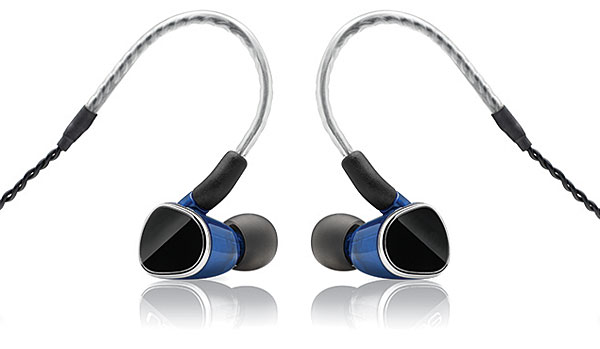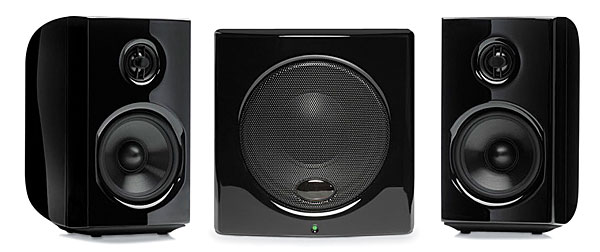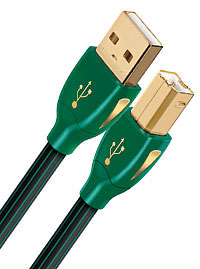I'm pretty old school. Extensive LP and CD library. I have a couple of CD's ripped from HD Tracks downloads and yes, they sound fantastic. My issue is storage. If I acquire a vast catalog of downloaded music in a high resolution format aren't I also needing a great deal of hard drive storage space? Granted it will take up less space than a CD or LP collection but aren't we still talking many many terabytes of data?
Guide To Hi-Res Audio - Gear Guide


Hi-Res Audio Gear Guide: To hear everything that Hi-Res Audio has to offer, you'll want high-quality playback.
Hi-Res Audio represents an opportunity to hear your music as never before. But to reveal all the added nuance and excitement that HRA brings to the plate over conventional streaming, downloads, and CDs, you'll want to have the right equipment. Here's a quick look at a few proucts—some common, some exotic—that will help you get the most from your hi-res music tracks.
 Portable Hi-Res Digital Music Players
Portable Hi-Res Digital Music Players
Smartphones equipped to store and play hi-res music in their native resolutions remain rare, but dedicated hi-res portable players are increasing in numbers. Prices start around $100 and range up to $3,500. What you get, besides compatibility with hi-res file types, are product designs that prioritize sound quality with more advanced components than those found in phones or typical players—particularly the important digital-to-analog converter and associated analog circuitry.
Digital-to-Analog Converters (DACs)
Virtually all audio-related products today contain a digital-to-analog converter, or DAC, that converts digital audio bitstreams into analog signals that can be played with amplifiers and speakers or headphones. These internal DACs are often chosen to achieve costeffectiveness, extend battery life or fit in a cramped chassis, but rarely for the best audio fidelity. The development of high-performance, standalone DACs is a phenomenon of the Hi-Res Audio movement that has, to date, primarily served high-end audiophiles—but not anymore. Audiophile-quality USB DACs that can be plugged into computers or smartphones and deliver sound to headphones or a home audio system now start at less than $50 and run up into several thousand dollars. DACs are a critical component in the sonic chain, and the upgrade to a dedicated DAC from the chips used in everyday cell phones and PC sound cards can be particularly noticeable, revealing the differences inherent in hi-res music files.
USB DACs come in several forms, including USB-powered dongles that plug into a laptop and output to headphones; battery-operated portable DACs with built-in high-quality headphone amplifiers; desktop/rack models that feed headphones or an existing stereo system through analog line-level outputs; and models that combine a DAC with a stereo integrated amplifier that can drive speakers directly. A potentially important feature for a USB DAC is asynchronous operation, which allows the DAC rather than the computer or network storage device to control the transfer of data, thus reducing timing errors that audibly degrade sound quality.

Premium Headphones/Headphone Amplifiers
Well-engineered, sonically revealing speakers or headphones are a critical link in the audio chain for discovering what’s truly special about Hi-Res Audio. Premium headphones, coupled with a good DAC/headphone amp combo or a portable hi-res music player, can be a great starter system for music lovers looking to get into the game or take their hi-res experience on the road. Headphone quality varies greatly, of course, even at higher price points, but with careful selection it’s probably safe to characterize $100 as a good entry-level price point for hi-res-friendly ’phones. Spending more (again, with careful shopping) will usually yield higher, even more revealing performance.
Speakers, Powered and Passive
For those not already equipped with a quality sound system at home, high-performance powered desktop speakers or studio monitors with built-in amplifiers can take Hi-Res Audio files off a DAC, or sometimes directly from a computer or network storage device, and provide an intimate, detailed sonic experience. Good-caliber systems start around $200.

Alternately, traditional passive bookshelf or tower speakers can be paired with a good-quality stereo receiver or integrated amplifier (with an attached or built-in DAC) for in-room playback of hi-res music.
The Bluetooth wireless protocol, even the premium aptX version, is not compatible with hi-res files. However, some wireless speakers and multiroom audio systems using Wi-Fi or AirPlay do boast hi-res compliance and can wirelessly send hi-res files intact from a home-network source to a distant powered speaker or ancillary sound system.

 A/V and Network Receivers
A/V and Network Receivers
Most audio/video receivers and so-called “network” stereo receivers or amplifiers sold today can be hooked up to a home network, then access Hi-Res Audio music files stored on a network-attached computer, hard drive or even hi-res-compatible cloud storage locker. These devices typically contain a good-quality DAC to decode hi-res files before sending them on to the attached speakers, though it should be noted that only in rare cases are these of the preferred “asynchronous” variety (see “Digital-to-Analog Converters”).
Specialty Audio Cables
Specialty manufacturers support Hi-Res Audio with premium cables to transfer digital audio over USB, coax, and optical connections, as well as with high-quality speaker and headphone cables.
- Log in or register to post comments


Yes, but that is cheap. I have two 3TB drives (one is physical backup). They're under $150 these days.

Yes hard drives are selling at bargain basement prices these days. The issue for me is I would need an entire forest of them to equal several thousand CD's worth of downloads. These files are BIG!

...and availability, for that matter.
If you're going to have nothing but disk-hungry, DSD 128 files, then you'll get only roughly 250 albums per 1 TB of disk space.
(See http://www.crutchfield.com/S-f83gBGf7jCd/learn/high-resolution-audio-gui...)
It's not like every digitized album is available in DSD 128.
I recently ripped 400+ CDs at 44.1/16 and it only cost me 138GB worth of space.

As noted above, you can fit about 250 high-res albums on 1TB...a 12TB WD My Book could hold almost 3000 high-res albums. Buy a 2nd one for backup purposes. True, that much storage is no longer cheap ($450x2).

Didn't realize hard drives had gotten that big. As you say not cheap but definitely doable if I'm going to go whole hog into this. Thanks.

They're not QUITE that big...the 12TB My Book uses (2) 6TB drives in RAID 0 or JBOD. You will need Windows 7 or more recent.

I'm a little surprised by the inference that a USB DAC is necessary. Most readers here will have a receiver with an HDMI input capable of handling multi channel high res audio.

...the server and the renderer - BOTH have to support the resolution that's been encoded and decoded. Some DLNA server solutions re-sample the files to 44.1 or 48 kHz, and some renderers can only receive up to a certain frequency via DLNA. Check your manuals FIRST, to (re)set your expectations.

Yes, my receiver can only handle high-res stereo tracks and not 5.1. However, my Oppo BD player can accept high-res 5.1 DLNA stream from Foobar2000 and transmit over HDMI to receiver. Or I can plug in laptop directly to receiver over HDMI with Foobar2000.

...you're an Apple fanboy who wants to overcome the 96/24 stock soundcard limit.

..."The Apple Fanboy's Guide to Downloadable Hi-Res Audio (and how to overcome the limitations of the Apple ecosystem)."
My goodness - outside of the FAQ's and Glossary, I don't think SACD was mentioned anywhere else... There sure were quite a number of iTunes mentions, though!

Quote "Hi-Res Audio tracks capture the details, instrument and vocal timber and textures" The only wood I want to hear is that of the speakers, I would much rather hear the timbre of the voices.
There is no mention of the provenance of the recordings, if I re record a cassette tape to 192/24 does it then become a Hi Res Music file?
The whole chain from artist's performance right through to the end product should be Hi Res, not just the final container file

there's been some advancement here on information of provenance, but a lot of it is private or lost.
in the hands of mastering 'masters', anything they are given can be taken up to 24/192 and be worthy of a listen. so yes, your statement is correct. it's the new hi-res master if they bothered.
if it's just up sampled it's a scam. no one is advocating that or selling it. when it sneaks through it's pulled and treated as a mistake. pono even offers a lifetime res upgrade.
most things aren't coming from cassette, of course. or 16/44, there's no point. if it's locked at 16/44 when recording it probably is, i don't think any label is in a hurry to get it to 24bit.
it's the old tapes and the new releases that are key here. the old tapes can be digitized again at 24/192, and then sold to consumers finally. the new sessions can be distributed that way, effectively giving the mp3 people their 10% version but still having an outlet for selling the full version.

Hi-res is all well and good, but I have not yet heard a major difference that would result in people like me - you know, regular people who have to worry about oh, you know, paying rent and utilities and buying food and shelter - spending a fortune to replace all the CDs we have with downloaded hi-res versions that usually cost between $25-$30 a pop. Hey, I can find great Blu-ray discs on the "A" site and other online retailers for less than $10, but if I had to pay 3 times that to download a hi-res version of the movie, I would tell them to go scratch. Why should hi-res audio be any different.

I'll admit...I have a high frequency hearing cutoff at around 4KHz (both ears), but I still enjoy my music and can have meaningful conversations. I'll also admit purchasing a Sony HAP-S1, HRA player that I like, very much.
Unfortunately, I disagree with most of the hype about HRA. Of the "scientific" studies I've read, all indicate that the (average) human ear simply cannot discern a difference between CD quality audio and HRA. The arguments against HRA are impressive, from the inability of the human ear to hear frequencies in excess of 20KHz, to the problem with the ability to listen (without extreme pain) to audio levels that span a 24dB range (or greater).
This HRA guide reproduces (again) an audio "waveform" that has been shown to be totally inaccurate, in the attempt to relate to the listener the difference between analog and digital audio. I don't know why this information continues to be reproduced, other than to convince non-technical types of the dubious differences between the two mediums. If it weren't for the fact that I work in the field of electronics and have kept abreast of the technological changes, since the tape and vinyl era, I, too, might have been sucked in by this "sleight of hand".
On a similar note...while I might discern the difference between a long run of 28 gauge speaker wire, versus 14 gauge and likely notice a difference of 64Kbps sampled audio, versus 44.1Kbps, you cannot convince me that I will hear the difference between plain copper and solid gold wires of the same gauge. You also would be hard pressed to convince me of the audio improvements between 44.1K and 96K sampled recordings. The differences are just too slight.
I do agree that CD quality audio is WAY better than either vinyl or tape...Hell, I grew up in the 60's and 70's and have heard it all. I also agree that HDTV (on a larger screen) beats the crap out of old 420 line video. Those are major differences that are easily discerned by the human ears and eyes...even ones as old and decrepit as mine. What I have been entirely unable to realize, however, is a noticeable difference in HRA over my CD collection. It just ain't happenin' here.
My final comment is, if you are looking to move up to HRA equipment and files...get your hearing checked, first. If your hearing qualifies as average to lower than average...save your money, as you will be unlikely to appreciate what you will be spending your hard earned money on.
Oh...I mainly purchased the Sony to: a. Have a desktop player with all my music onboard and b. To prove or disprove the HRA hype. I'm good with a., but b. has totally failed to convince me.

The discussion of Radio Randy hit home with me. I love my music but suffer similar hearing difficulties (too much loud music in the 60's and 70's) I'll stick with my vinyl, CD's and occasional iTunes download. Thanks for the article.

First its our girlfriends and wife's convincing us not to buy any audio-video gear cause they can't tell the difference. Now we are going in to the doctor's office and asking his advice.? If you love music and your hearing is bad (get a hearing aid)! your bound to start hearing everything again.(which could save your life !) The problem is that most of us don't really listen. If the average person sat down with a blind person and they hear the same track.. that's because their auditory senses are developed. The other problem that many of us might be suffering from is called (auditory processing disorder)its a glitch in the brains ability to filter and process sounds. If you've never played an instrument and done any studio work you ear is not developed. Unless your gifted. But really the most important thing is that everybody listens to music, in what ever format. The more you listen the better you get at listening. Get in your favorite chair, close your eyes and try to pick out every instrument. you will start hearing things you didn't know was there. Listen to Hi-res,non Hi-res, different volumes, different amps,speakers ect. That's all part of loving the gift of MUSIC !



















































